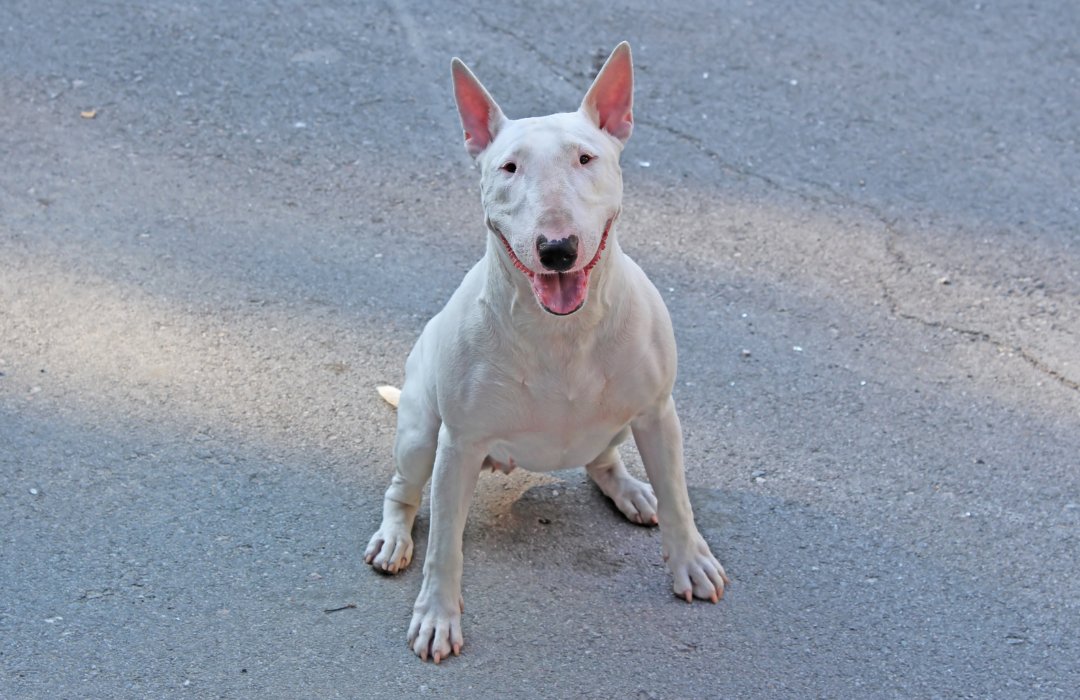
Do Bull Terriers Sweat?
|
Time to read 5 min
|
Time to read 5 min
©MG-54 via Canva.com
Bull Terriers are a lively and lovable breed known for their distinct egg-shaped heads and playful personalities. As a responsible pet owner, you want to ensure your Bull Terrier stays comfortable and healthy, especially during hot weather. One common question that arises is whether Bull Terriers sweat like humans to cool down. In this article, we'll explore the fascinating world of canine cooling mechanisms to uncover the truth behind the question: Do Bull Terriers sweat?
Yes, Bull Terriers, like all dogs, do have sweat glands, but they are quite different from those found in humans. Dogs possess two types of sweat glands: eccrine and apocrine glands.
Dogs have eccrine sweat glands, primarily located in their paw pads. These glands secrete a small amount of watery sweat, which plays a minor role in cooling compared to humans. Instead of relying on sweating, dogs have evolved more effective cooling methods, such as panting.
Unlike eccrine glands, which are found in paw pads, apocrine sweat glands are scattered throughout a dog's skin, including their ears. However, the sweat produced by these glands isn't for cooling purposes. Apocrine sweat glands release a different type of sweat, containing various chemicals that contribute to the unique scents dogs use for communication with other animals.
To determine whether Bull Terriers sweat, it's crucial to explore how dogs regulate their body temperature. Unlike humans, dogs do not possess an extensive network of sweat glands distributed all over their bodies. Instead, they have sweat glands primarily concentrated in their paw pads. However, these glands play a limited role in cooling compared to humans.
The sweat glands in a dog's paw pads secrete a small amount of moisture, which evaporates on the surface, aiding in slight cooling. However, due to the relatively low number of sweat glands, dogs are not as efficient at sweating as humans. Consequently, sweating is not the primary cooling mechanism for dogs, including Bull Terriers.
Instead of relying on sweating to regulate body temperature, dogs, including Bull Terriers, have evolved other effective cooling methods. One of the most prominent methods is panting.
As mentioned earlier, dogs have sweat glands, but sweating is not their primary cooling mechanism. Instead, dogs have evolved an efficient and natural cooling method called panting, which plays a crucial role in regulating their body temperature, including Bull Terriers.
When Bull Terriers (and other dog breeds) pant, they breathe rapidly and shallowly, helping them release excess heat from their bodies. Panting serves as a built-in cooling system, especially during warm weather or after engaging in vigorous physical activities.
One of the key benefits of panting is that it allows dogs to expel warm air from their lungs, facilitating the cooling process. As dogs pant, moisture evaporates from their tongues and the lining of their lungs, promoting heat loss and helping to keep their body temperature at a safe level.
Panting is a natural and instinctive behavior in dogs. When they feel warm or need to cool down, they automatically resort to panting as an effective means of thermoregulation.
It's important to recognize and respect this natural cooling mechanism, ensuring your Bull Terrier has ample opportunities to pant and cool off during hot weather or after active play sessions. By allowing them to pant freely, you contribute to their overall well-being and comfort, making them a happy and healthy canine companion.
As a Bull Terrier owner, ensuring your furry friend stays cool and comfortable during hot summer months is crucial. Taking proactive steps to protect them from the heat will contribute to their overall well-being and happiness. Here are some practical and easy-to-follow tips to keep your Bull Terrier safe and cool in warm weather:
Heat stroke is a severe and potentially life-threatening condition that can affect dogs. It occurs when a dog's body temperature rises to dangerous levels, surpassing their ability to cool down effectively.
Symptoms of heat stroke in Bull Terriers may include excessive panting, profuse drooling, a rapid and irregular heartbeat, weakness, and even collapse. If your Bull Terrier displays any of these signs, it is crucial to take immediate action.
If you suspect heat stroke, quickly move your Bull Terrier to a cooler area with better ventilation. Applying cool (not cold) water to their body can aid in bringing down their body temperature. Avoid using ice-cold water, as it may cause shock.
Heat stroke is an urgent medical emergency, and you should seek immediate veterinary attention for your Bull Terrier. Delaying treatment could lead to serious complications and put your furry companion's life at risk.
Preventing heat stroke is essential. Ensure your Bull Terrier has access to shade and plenty of fresh water during hot weather. Limit physical activities to cooler times of the day, and never leave your pet in a hot car, as temperatures can escalate rapidly.
By being vigilant and taking proactive measures, you can help your Bull Terrier stay safe and cool during hot weather, ensuring they enjoy a happy and healthy life by your side.
While Bull Terriers do have sweat glands, their ability to cool through sweating is limited. Instead, they rely on panting as their primary cooling mechanism. As a Bull Terrier owner, understanding their unique cooling needs and taking appropriate precautions during hot weather is vital to ensure they stay healthy and happy. By providing shade, fresh water, and limiting outdoor activities during peak heat, you can enjoy a wonderful time with your Bull Terrier, knowing they are well cared for and safe in any weather!